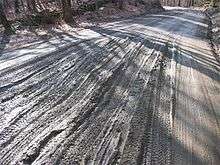Mud season
Mud season is a period in late winter / early spring when dirt paths and roads become muddy from melting snow and rain.
Mud season occurs in places where the ground freezes in winter and thaws in spring. Dirt roads and paths become muddy because the deeply frozen ground thaws from the surface down as the air temperature warms above freezing. The frozen lower layers of ground prevent water from percolating into the soil so the surface layers of soil become saturated with water and turn to mud.
Etymology
The term mud season is used in northern climates, particularly in rural northern New England and the northern areas of the Great Lakes. It is often jokingly called the "fifth season".[1]
A similar term, rasputitsa, is used in Russia and other Eastern European countries.[2]
Expense
Mud season can be expensive for towns due to the damage done to dirt roads. One report concluded that the cost of re-engineering dirt roads so that they would remain passable during mud season in the state of Vermont could run as high as US$140,000 per mile.[3]
Cultural references
In Maine, Vermont, and New Hampshire, the phrase "mud season" can be used as a shorthand reference to the vicissitudes and peculiarities of life in the region. The term has been used as the title of magazines,[4] books,[5] and at least one movie.[6]
References
- "Mud Season - New England' fifth season". newengland.com.
- Zielinski, Gregory A.; Keim, Barry D. (2003). New England Weather, New England Climate. UPNE. p. 91. ISBN 9781584655206.
- Major, Ian. "Mud season madness". basementmedicine.org.
- "Mud Season Review". Mud Season Review.
- Stimson, Ellen (7 October 2013). "Mud Season: How One Woman's Dream of Moving to Vermont, Raising Children, Chickens and Sheep, and Running the Old Country Store Pretty Much Led to One Calamity After Another". Countryman Press – via Amazon.
- "Mud Season". 24 January 1999 – via www.imdb.com.
